Syds Johannes Rienks, 1770 - 1845
Biense Siedses Rienks, 1830 - 1891
by Brian Stevenson
last updated February, 2025
S.J. Rienks was particularly notable for his developments of reflecting microscopes. These used curved mirrors for magnification, thereby avoiding the chromatic and spherical aberrations of glass lenses. For most of his life, he lived in Friesland (Frisia), Netherlands, working as a farmer. He and several neighboring farmers learned and shared skills for building scientific apparatus. Rienks moved to Leiden in 1826 to open a business that produced and sold microscopes and other instruments. After he died, son Biense continued the business, although moving to Amsterdam ca. 1860s.
Also of note, the Rienks served as master to Johannes J. Zaalberg van Zelst (1827-1903), who also manufactured microscopes but is best known as a maker of microphotographs. Zaalberg van Zelst opened a shop in Amsterdam ca. 1848, so probably began his apprenticeship with Syds and completed it with Biense.
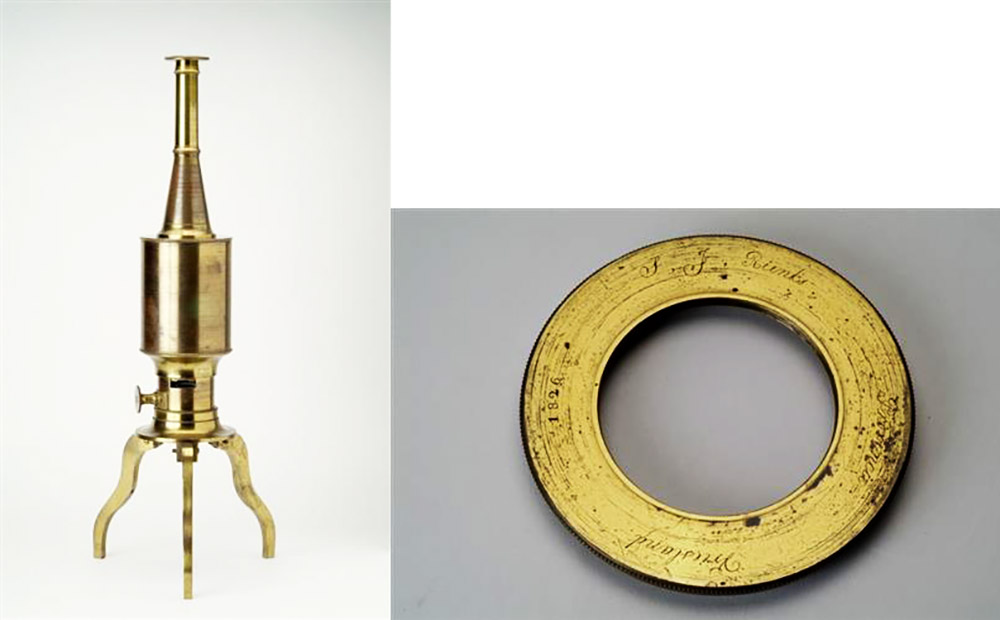
Figure 1.
An S.J. Rienks reflecting microscope, dated 1826 and marked as having been built in Friesland, currently held in the Boerhaave Museum, Leiden. The Billings Microscope Collection has a similar microscope from Friesland, dated 1825. Adapted for nonprofit, educational purposes from https://mmb-web.adlibhosting.com/Details/collect/9555
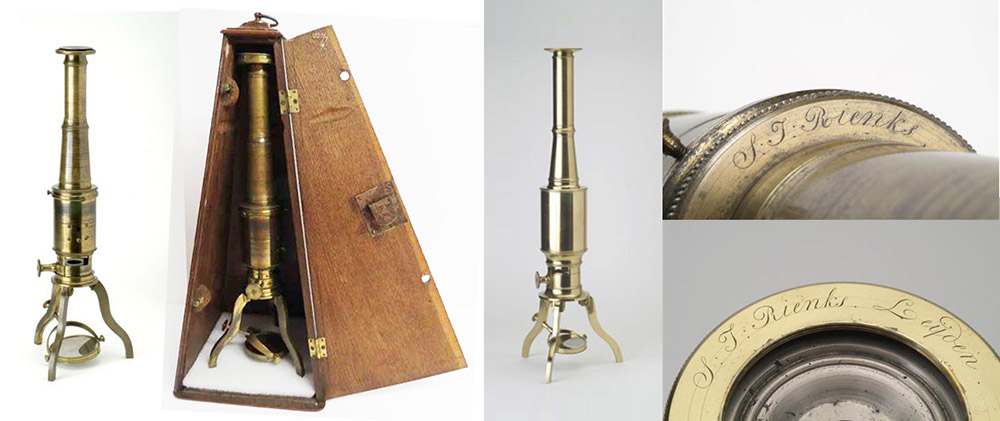
Figure 2.
Two reflecting microscopes that were built by Rienks in Leiden, and are currently held in the Boerhaave Museum. Adapted for nonprofit, educational purposes from https://mmb-web.adlibhosting.com/Details/collect/4027 and https://mmb-web.adlibhosting.com/Details/collect/9554

Figure 3.
A pocket-sized reflecting microscope by Rienks, which consists of a single mirror, currently held in the Boerhaave Museum. Fournier reports that ca. 1810 Rienks “made a pocket microscope for opaque specimens after his own invention with a (ca. 3.7 cm) mirror, which he presented to Abraham Ypelaar”. She also reports that Rienks exhibited such an instrument at an exhibition in 1844. Adapted for nonprofit, educational purposes from Fournier and https://mmb-web.adlibhosting.com/Details/collect/17414
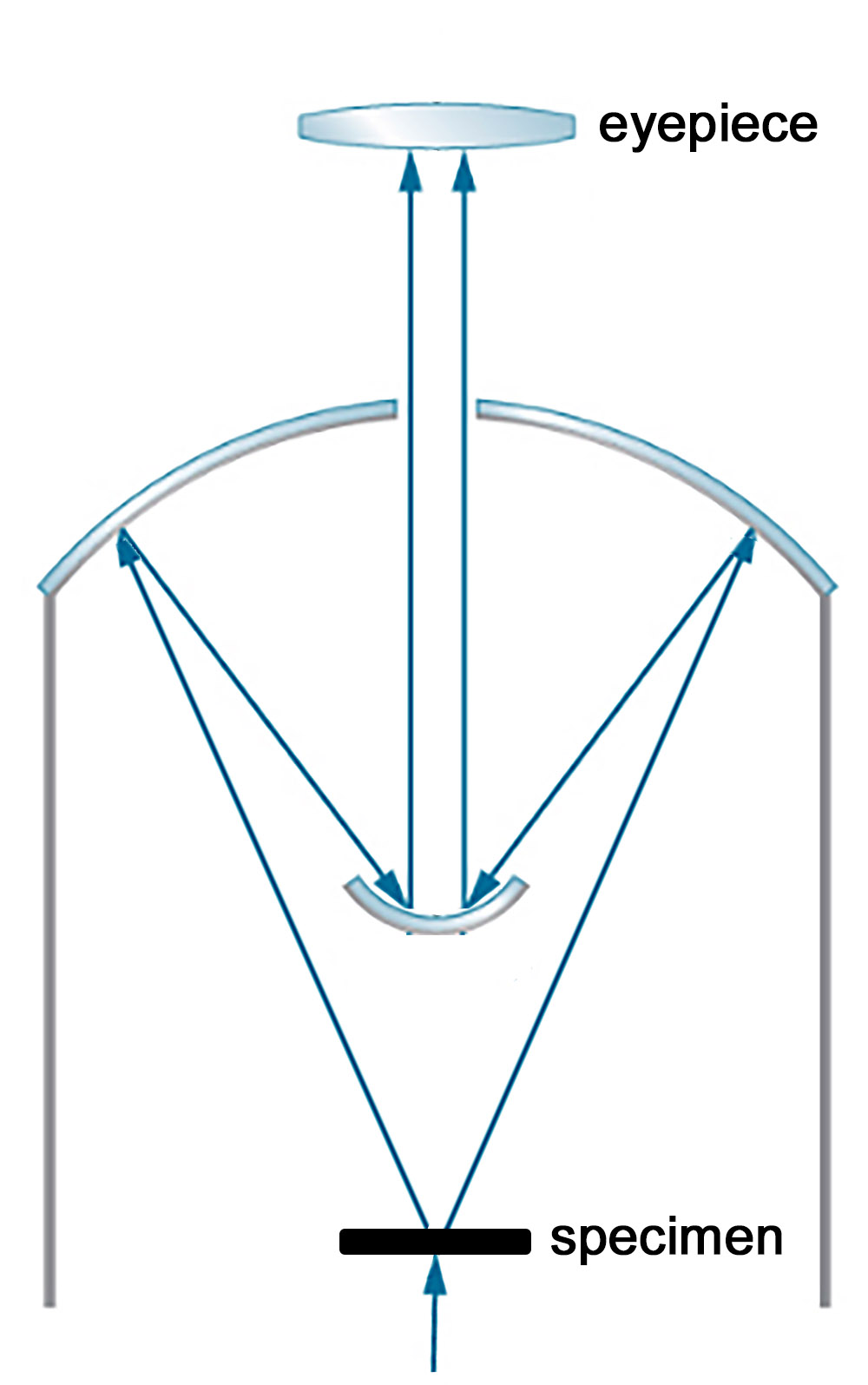
Figure 4.
Diagram of the concept of a reflecting microscope: light passes from the specimen to curved mirrors that magnify the image. Adapted for nonprofit, educational purposes from https://phys.libretexts.org/Bookshelves/University_Physics/University_Physics_%28OpenStax%29/University_Physics_III_-_Optics_and_Modern_Physics_%28OpenStax%29/02%3A_Geometric_Optics_and_Image_Formation/2.09%3A_Microscopes_and_Telescopes
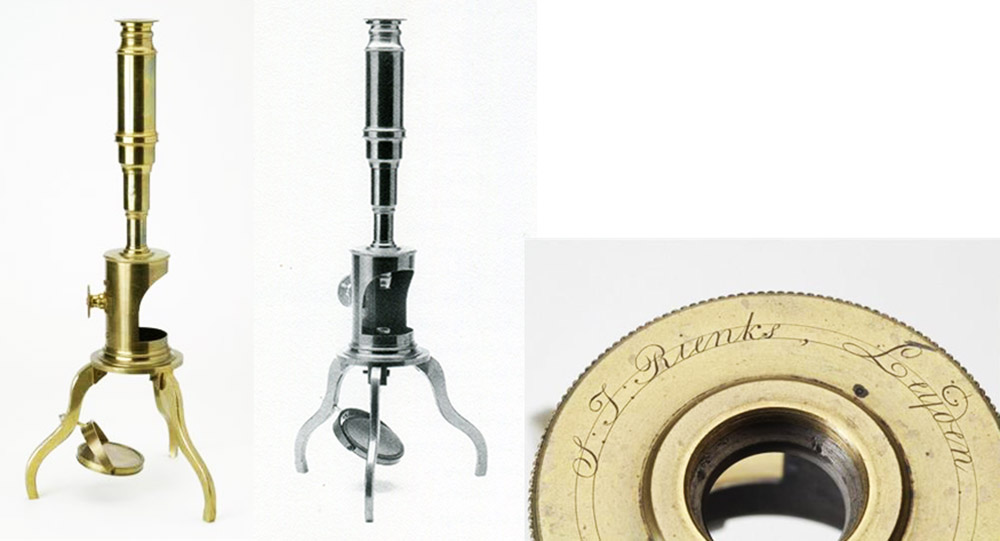
Figure 5.
A compound microscope, which uses glass lenses, by Rienks, from the Boerhaave Museum. Adapted for nonprofit, educational purposes from Fournier and https://mmb-web.adlibhosting.com/Details/collect/17323
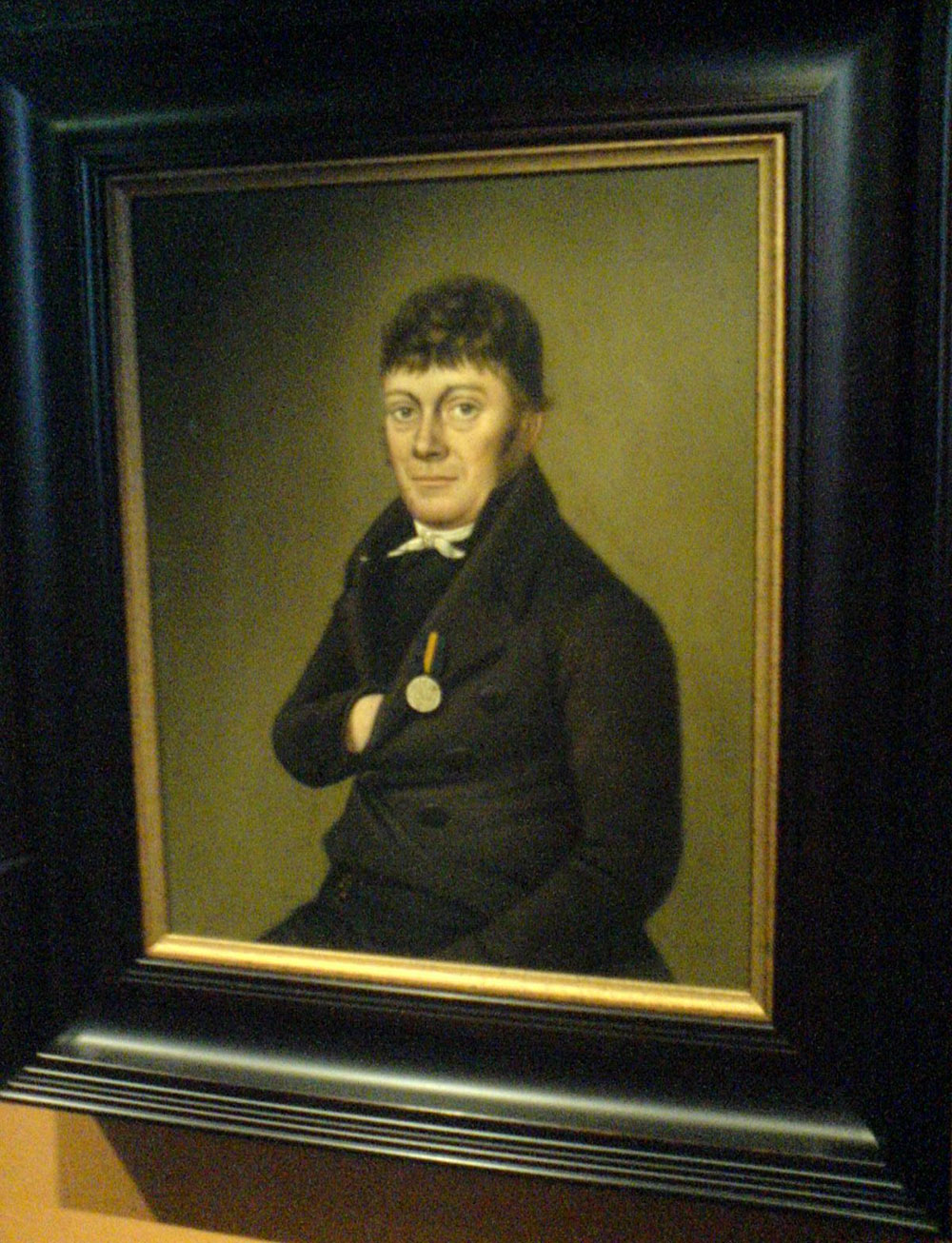
Figure 6.
Portrait of Sieds Johannes Rienks, currently in the Eise Eisinga Planetarium, Franeker, Netherlands.
Syds Johannes Rienks was born on October 6, 1770 in Marrum, Friesland (Fresia). He was the second child of Johannes Rienks Rienks and Aukje Siedses Boersma, and grew up working on the family farm.
The neighborhood included a number of other people who were interested in education and construction of scientific instruments. Rienks taught himself how to turn metal with a lathe. He then learned how to grind and polish lenses from neighbor and noted amateur astronomer Arjen Roelofs (1754-1828), and his brothers Pieter and Albert. After Pieter and Albert Roelofs died (in 1801 and 1809, respectively), Rienks and Arjen Roelofs worked in partnership, with Roelofs making the calculations and designs, and Rienks doing the construction.
Rienks initially made glass lenses for spectacles and microscopes, but began to experiment with the use of mirrors for microscopes and telescopes just before the turn of the nineteenth century.
Syds Rienks married Grietje Dirks Hellinga on October 7, 1798. They had five children: three girls and two boys.
Although he was primarily a farmer, Rienks traveled extensively to work and enhance his knowledge of optics and machining. Around 1805 he worked for several months in factory of Jacob Hendrik Onderdewijngaart Canzius (1771-1838), a Delft manufacturer of scientific instruments.
Circa 1809, Rienks built a pocket microscope similar to that shown in Figure 3, and gave it to Abraham Ypelaar (1736-1811), a well-known preparer of microscopical objects. He is reported to have also given telescopes to the King and to academics, rather than selling them.
Rienks exhibited at an 1809 exposition in Amsterdam where his telescopes caught the attention of King Louis Bonaparte, leading to a royal commission to build a two-foot telescope. Rienks also exhibited at Ghent (1820), Haarlem (1825), Brussels (1830), and Leeuwarden (1844).
In 1818, Rienks was commissioned by King William I to build two 13-foot telescopes, for observatories in Leiden and Utrecht.
Syds and Grietje divorced in 1822. He married Siedske Wiebes de Jong on November 27, 1822. Syds had five further children with Siedske, three boys and two girls.
The Rienks moved to Leiden in 1826, where most of his known microscopes and telescopes were produced.
Syds Rienks died on November 15, 1845, after which a son, Biense, took over the business. It was during that time that J.J. Zaalberg van Zelst apprenticed with the Rienks business. Biense moved to Amsterdam in about 1860, then to The Hague around 1880.
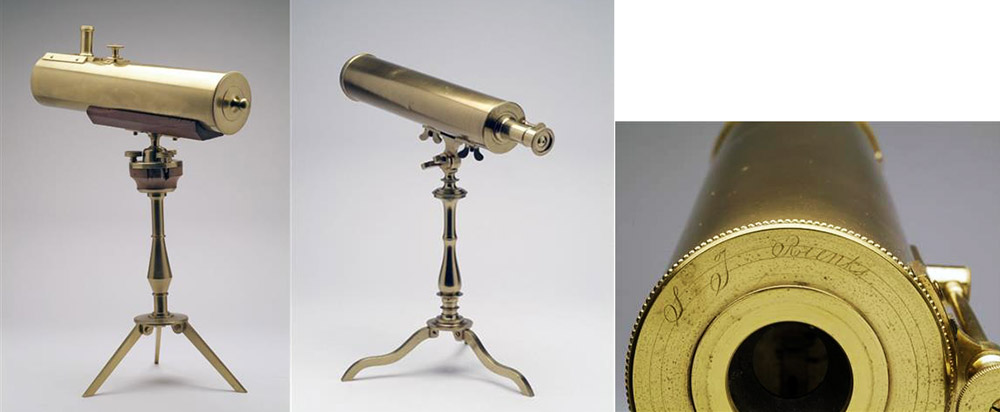
Figure 7.
Two reflecting telescopes by S.J. Rienks, in the Boerhaave Museum. Adapted for nonprofit, educational purposes from https://mmb-web.adlibhosting.com/Details/collect/10350 and https://mmb-web.adlibhosting.com/Details/collect/10354
Resources
Find-a-Grave (accessed February, 2025) findagrave.com/memorial/262970792/sieds-johannes-rienks
Fournier, Marian (2003) Early Microscopes, A Descriptive Catalogue, Museum Boerhaave, Leiden, pages 191-193, 214, and 216
Hansen, J.L., W.A. Schrader, W.R. Cowan, J.E. Henderson, O.W. Richards, H.R. Purtle, and J.A. Ey (1974) The Billings Microscope Collection of the Medical Museum Armed Forces Institute of Pathology, Washington, D.C., pages 30-31, Figure 57
Netherlands census records, accessed through www.wiewaswie.nl/
Netherlands vital records, accessed through ancestry.com
Rooseboom, Maria (1950) Bijdrage tot de Geschiedenis der Instrumentmakerskunst in de Noordelijke Nederlanden tot Omstreeks 1840, Rijksmuseum voor de Geschiedenis der Natuurwetenschappen, Leiden, page 118






